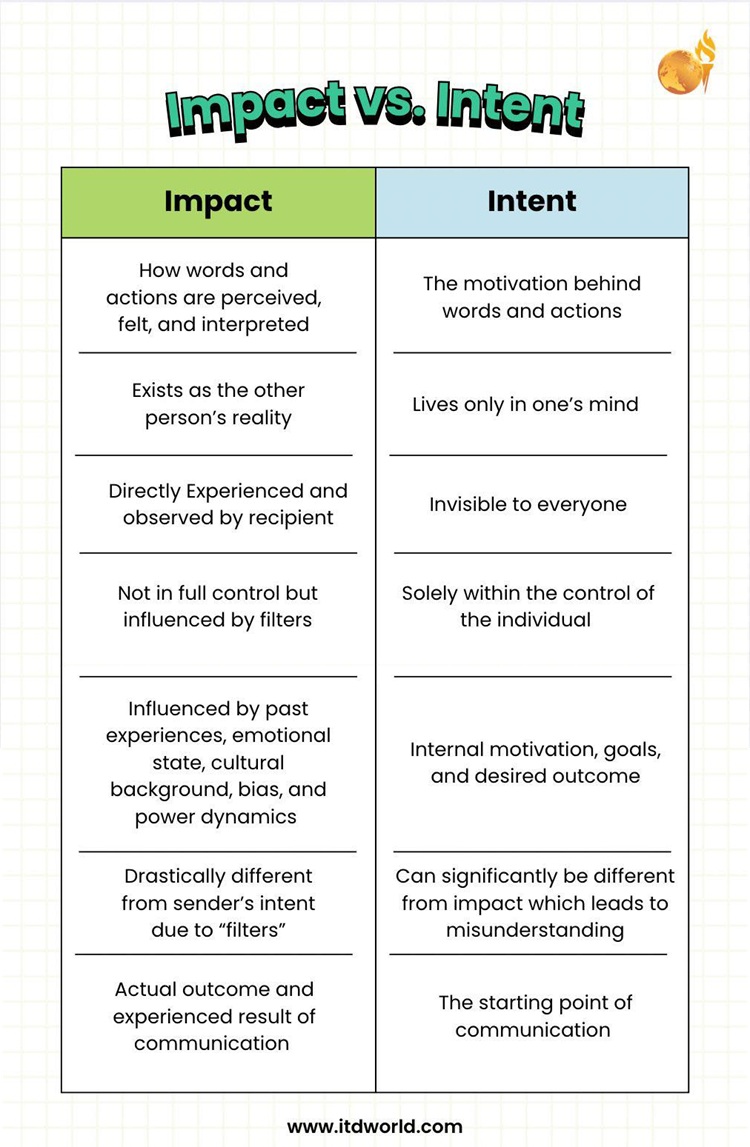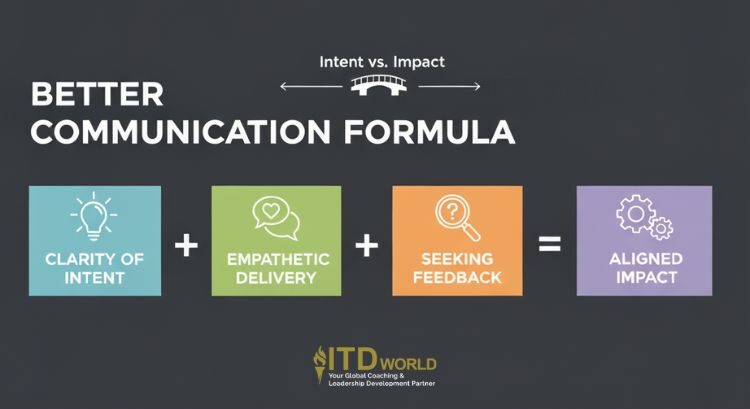A complete playbook for leaders, managers, and teams to navigate the issue of intent vs impact in the workplace.
Have you ever said something with the best of intentions, only to see it land completely the wrong way – causing confusion, frustration, or even hurt? This common experience highlights the problem of “Intent vs Impact,” one of the most frequent and damaging sources of conflict and misunderstanding in the workplace. The ability to close this gap is not a soft skill; it is a critical competency for effective communication, collaboration, and leadership.
|
Author: Jonathan M. Pham |
Highlights
- The gap between intent (our unstated motivations) and impact (how our actions are perceived by others) is the root cause of misunderstandings, conflict, and distrust; it arises because our messages are filtered through others’ unique contexts and experiences.
- Consistent misalignment erodes trust, costing companies billions in lost productivity and turnover, significantly hindering Diversity, Equity, and Inclusion (DEI) efforts by perpetuating microaggressions, and placing a magnified responsibility on leaders.
- While both are important, impact should always be addressed first in a communication breakdown to validate the other person’s experience and de-escalate conflict, with clarifying intent following as a secondary step to provide context and repair the relationship long-term.
- Bridging the intent-impact gap in the workplace involves a proactive approach: clarifying your intent by defining goals and considering your audience before communicating, delivering with empathy through active listening and observing non-verbal cues during the interaction, and closing the loop afterward by soliciting feedback and using a three-step repair kit (thank, apologize, clarify) if misunderstandings occur.
What is Intent and Impact? Understanding the Gap & Key Differences
At the heart of every human interaction are two distinct elements: the intent behind our actions and the impact those actions have on others. The gap between these two is where misunderstanding, conflict, and distrust are born.
- Intent: This refers to the motivation behind your words or actions. It is what you hope to communicate and achieve. Your intent – whether it is to be helpful, efficient, or constructive – lives only in your own mind and is invisible to everyone else.
- Impact: This is how your words or actions are actually perceived, felt, and interpreted by the other person. It is their reality, and it is created the moment your message is received.
The gap between intent and impact opens up because our message never travels in a vacuum. It is always sent through the “filter” of the other person’s context, which is composed of many factors:
- Their past experiences and personal history.
- Their current emotional state and stress level.
- Their cultural background and unconscious biases.
- The power dynamics of the relationship (e.g., manager to employee).
A well-intentioned message can be easily distorted as it passes through this filter, leading to an effect completely different from what one meant.
| Feature | Intent | Impact |
| Definition | The motivation behind words or actions; what one hopes to communicate and achieve. |
How words or actions are actually perceived, felt, and interpreted by the other person.
|
| Location/Realm | Lives only in one’s own mind. |
Exists as the other person’s reality; created upon message reception.
|
| Visibility | Invisible to everyone else. |
Directly experienced and observed by the recipient.
|
| Control | Solely within the control of the individual sending the message. |
Not fully within the control of the sender; influenced by the recipient’s “filter.”
|
| Factors Influencing | Internal motivations, goals, desired outcome. |
Recipient’s past experiences, emotional state, cultural background, unconscious biases, power dynamics.
|
| Potential for Misalignment | Can be significantly different from the impact, leading to misunderstanding. |
Can be drastically different from the sender’s intent due to the recipient’s “filter.”
|
| Role in Communication | The starting point of communication. |
The actual outcome and experienced result of communication.
|
Key differences between intent vs impact

Intent vs Impact: Example in Communication
Let’s consider the following situation:
A manager is walking out the door at 5:30 PM after a long day. An employee, eager for input, catches them and asks for a quick look at a report they just finished.
The intent: The manager, wanting to be efficient and responsive, quickly scans the document and says, “This is a good start, but the data on slide five needs to be redone and the conclusion is a bit weak. Let’s fix it tomorrow morning.” In saying so, they aim to provide quick, direct, and helpful feedback to save time and address the issue promptly.
The impact: The employee, who worked hard on the report, doesn’t hear “helpful and efficient.” What they perceive is a rushed, critical dismissal of their work right at the end of the day. As such, they feel devalued, demoralized, and are left feeling anxious about their performance overnight.
As demonstrated in the example above, the manager’s positive intent became a negative impact because it was filtered through the context of poor timing (rushed), blunt delivery, and the inherent power dynamic of the relationship.

Intent vs effect: What insensitive actions or words may result in
Intent vs Impact in the Workplace: Why Do They Matter?
The high cost of misalignment
When a gap between intent and impact becomes a pattern, it erodes the single most important ingredient of any high-performing team: trust – without which innovation and collaboration cannot flourish. An environment where people constantly have to guess at the meaning behind actions or where they feel their negative experiences are dismissed is, by definition, a low-trust one.
The business cost of this breakdown is enormous. Studies on workplace communication have estimated that misunderstandings and poor communication cost companies billions of dollars annually in lost productivity and high employee turnover.
The critical link to Diversity, Equity, and Inclusion (DEI)
Nowhere is the intent vs impact gap more critical than in the context of DEI. Many microaggressions – subtle, often unintentional comments or actions that communicate a hostile or derogatory message to someone from a marginalized group – are a direct result of a disconnect between intent and impact.
Example: A manager might tell a Black employee, “You are so articulate,” with the intention of giving a genuine compliment. However, the impact may turn out to be demeaning, as it may imply that being articulate is a surprising or unusual trait for someone of their background. It reinforces harmful stereotypes and undermines the employee’s sense of belonging.
According to research from sources like McKinsey, a primary reason employees from underrepresented groups leave their jobs is a lack of psychological safety and a feeling of not being included. Addressing the intent vs impact gap is therefore a non-negotiable requirement for fostering a truly inclusive culture.
Read more: Organizational Culture – The Invisible Force Behind Success
The leader’s magnified responsibility
While the above-mentioned dynamic affects everyone, the responsibility to manage it falls most heavily on leaders and coaches – due to the inherent power dynamics of their roles. A leader’s words and actions carry more weight and have a much larger ripple effect on team morale, psychological safety, and performance.
Example: A casual, off-the-cuff remark from a peer about a presentation might be quickly forgotten. However, the exact same remark from a team lead is likely to be interpreted as official feedback or a sign of their deep displeasure, creating anxiety that last for days. Because their impact is magnified, leaders must be exceptionally mindful of how their actions are likely to be perceived.
Intent vs Impact in the Workplace: Which is More Important?
When a communication breakdown occurs, a natural tension arises between the speaker’s original intention and the listener’s perception. The former wants to be judged by their good faith, while the latter is left dealing with the reality of the negative effect. The question is: which one should be prioritized?
The most common and counterproductive reaction to being told your words had an unwanted impact is to immediately defend your intentions with a response like “But that’s not what I meant!” or “You’re misunderstanding me; I was only trying to help.” Which understandable, such a reaction is a critical mistake.
By leading with your intent, you are implicitly dismissing and invalidating the other person’s feelings. Your action shifts the focus from their experience to yours – in other words, you are essentially telling them that their emotional response is wrong or an overreaction. This immediately derails any chance of a productive conversation and only escalates the conflict.
To navigate the situation successfully, leaders must follow a simple but powerful golden rule: Acknowledge the impact first. Before any resolution can occur, the person who experienced the effect must be allowed to feel heard, seen, and validated. Their reality of the situation must be acknowledged as legitimate to them, even if you don’t fully agree with their interpretation.
In practice: The conversation should start with acknowledging their reality. For instance:
“Thank you for being honest with me about that. I can see now that my comments landed in a way that was hurtful, and I am truly sorry for it.”
“It sounds like what I said came across as dismissive. I apologize for making you feel that way.”
Such an empathetic response immediately de-escalates the situation and opens the door for a real conversation. This does not mean your intent is irrelevant – its role is simply second. Once you have validated the other person’s experience, they become far more receptive to knowing your perspective.
In practice: After acknowledging the impact, you can then gently clarify your original intention. For example: “…I am truly sorry. I did not mean to dismiss your work, but to give you quick feedback before I left for the day. I can see now that my timing and delivery were poor, and that is something I will be more thoughtful about in the future.”
The above-mentioned reply does not excuse the negative impact, but it provides crucial context, demonstrates self-awareness, and shows a commitment to change – all of which are essential for rebuilding trust.
So, which matters more? In the heat of the moment, the impact is what creates the immediate reality and must always be addressed first. Your intent becomes crucial for the second step: the long-term repair of the relationship.
Read more: 7 Leadership Mistakes to Avoid

Impact is more important than intent
How to Bridge the Gap Between Intent vs Impact in the Workplace
The formula for better communication: Clarity of Intent + Empathetic Delivery + Seeking Feedback = Aligned Impact
While it is crucial to know how to repair a gap after it occurs, the most effective leaders would work proactively to prevent the issue from emerging in the first place. This requires a conscious and disciplined approach to communication. The following playbook breaks down the key actions to take before, during, and after any important interaction to ensure your positive intent is felt.

-
Before you communicate: Setting clear intent
Thoughtful preparation is the foundation for aligning intent with impact. A few moments of reflection before you speak can prevent hours of cleanup and repair work later.
- Define your goal
Before initiating a conversation, it’s a good idea to spend time pondering these two critical questions: “What is the single most important message I want this person to take away?” and “What do I want them to think, feel, and do after this conversation is over?” This clarity of purpose will shape your entire approach.
- Consider your audience
Think about the “communication filter.” Ask yourself, “How might this person perceive my message, given their current workload, recent experiences, or our relationship? Is this the right time and place for this conversation?” Anticipating their perspective allows you to better frame your message.
Read more: Thoughtful Leadership – Why It Matters in Today’s Hectic World
-
During the communication: Delivering with empathy
How you deliver a message is just as important as the words you use. This phase is about being present, attuned, and responsive to the other person.
- Practice active listening
Give the other person your full attention. Listen to understand their perspective without formulating your rebuttal. Then, summarize what you hear to confirm understanding (e.g., “So what I’m hearing is…”).
- Observe non-verbal cues
Pay close attention to body language, tone of voice, and facial expressions – both yours and theirs. These typically convey more than words.
Example: If you are sharing feedback and you see the other person’s shoulders slump or they break eye contact, it’s a crucial cue that your message is having a strong impact. This is a perfect moment to pause and check in by asking, “How is this landing for you?”
-
After you communicate: Closing the loop & repairing gaps
The conversation isn’t over when you stop speaking. The final step is to ensure your message was received as intended – and to close any gaps that may have opened.
- Proactively solicit feedback
Don’t just hope your message landed well – find out if it does. This is a powerful habit that demonstrates humility and a commitment to clear communication.
Example: At the end of a significant conversation, try asking a simple, clarifying question like, “To make sure we’re on the same page, what are your key takeaways from this discussion?” This should immediately reveal any disconnect.
- When a misunderstanding occurs (the repair kit)
If you realize your impact was negative despite your good intentions, consider making use of the following simple, three-step toolkit based on the principle of acknowledging impact first.
-
- Give thanks: “Thank you for being honest with me about how that impacted you.”
- Say sorry: “I am genuinely sorry my words had that effect. That was not my intention.”
- Clarify and realign: “My goal was to [state your positive intent]. How can we move forward productively from here?”
Read more: Gratitude in the Workplace – A Reflection on Its Miraculous Power
Managing impact over intent
Intent vs Impact Worksheet
Purpose of This Tool:
This worksheet is a practical tool to help you proactively plan for important conversations or to reflect on a past interaction where your intent did not match the impact. By thoughtfully considering each step, you can build the skill of aligning your positive intentions with a positive impact.
Section 1: The Communication Scenario
Describe the specific interaction you want to plan for or analyze (e.g., giving performance feedback, addressing a missed deadline, discussing a sensitive topic).
Section 2: Before the Interaction – Planning for Alignment
Use this section to prepare for an upcoming conversation.
1. My Core Intent:
(What is the key message I want to send? What do I want the other person to think, feel, and do after our conversation?)
2. Considering the Other Person (The “Filter”):
(What might be their current context, stress level, or perspective? How might they perceive this message? Is this the right time and place?)
Section 3: After the Interaction – Reflection & Repair
Use this section to debrief a conversation that has already happened.
1. The Actual Impact:
(How did the other person react? What did their verbal and non-verbal cues (tone, body language) tell me about how my message was received?)
2. Analyzing the Gap:
(Was there a gap between my intent and the actual impact? If so, why do I think the gap occurred? (Consider timing, my word choice, my tone, their context, etc.))
3. The Repair Plan (if a gap exists):
(Use the “Repair Kit” to plan your follow-up conversation.)
- Acknowledge & Thank: How can I acknowledge the impact and thank them for their honesty? (e.g., “Thank you for sharing that…”)
- Apologize for the Impact: What can I say to apologize for the negative effect? (e.g., “I am sorry my words made you feel…”)
- Clarify Intent & Realign: How can I state my positive intent and ask how to move forward? (e.g., “My intention was to… How can we get back on track?”)
Section 4: My Key Takeaway
What is the one thing I will do differently in my next important conversation based on this analysis?
Read more: Ego in the Workplace – The Hidden ‘Evil’ Behind Team Dysfunctions
Quotes About Intent vs Impact in the Workplace
We judge ourselves by our intentions and others by their behavior.
Stephen M.R. Covey
We are not our best intentions. We are what we do.
Amy Dickinson
Impact matters more than intention. I have hurt more people with a clear heart than I ever have with malice, but the clean lines of my intentions don’t negate the impact.
Jeanette LeBlanc
Your intention is irrelevant if your impact is harmful.
Brandon Kyle Goodman.
The road to hell is paved with good intentions.
Proverb

Intent vs impact at work
How ITD World’s Coaching & Training Solutions Can Help
Mastering the gap between intent and impact is a core emotional intelligence skill crucial for modern leadership, effective collaboration, and building an inclusive culture. Developing the deep self-awareness and sophisticated communication habits required to do this consistently is a journey – one that can be accelerated with expert guidance and a dedicated partner.
At ITD World, we specialize in training the essential human-centric competencies that enable leaders and teams to communicate with greater clarity and empathy. Our programs are designed to help you and your organization close the intent vs impact gap and foster a high-trust environment.
- Communication & influence workshops: Designed to provide practical frameworks and hands-on practice for delivering messages with empathy, clarity, and impact, ensuring your intent is understood.
- Emotional intelligence (EQ) training: We help leaders cultivate the foundational self-awareness and social awareness needed to perceive and manage the intent vs impact dynamic in themselves and their teams.
- One-on-one executive coaching: This provides a confidential, personalized space for leaders to receive direct feedback on their communication style and work with an expert coach to identify and close their specific blind spots.
- Diversity, Equity & Inclusion (DEI) Programs: Revolving around the habits of inclusive communication, so that teams may be better equipped to navigate sensitive conversations and manage the intent vs impact gap in a diverse workforce.
Ready to build a culture of clearer communication and higher trust? Contact ITD World today to learn how our solutions can help you and your team.
Other resources you might be interested in:
- Cross-Cultural Communication: Guide for Leaders & Coaches
- Constructive Feedback: Making Input Matter
- Team Coaching: Guidelines for High Performance
- Human Leadership in a Digital World: Skills & Strategies for Success
- Leading With Impact: Translating Your Presence Into Performance

